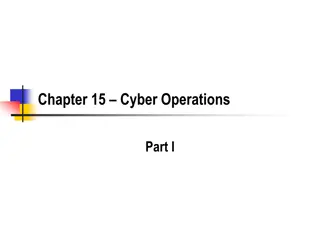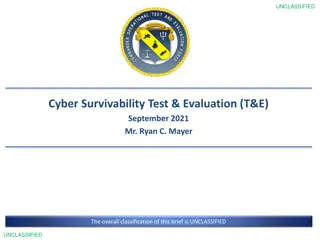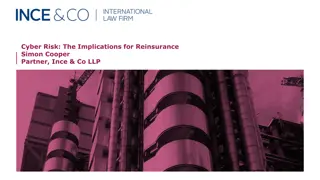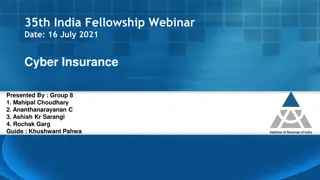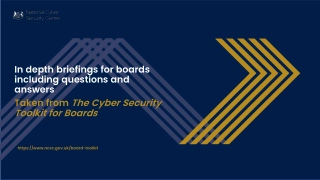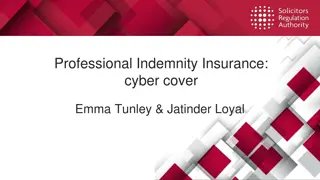Cyber Risk in Financial Sector: Implications & Resilience
Explore the evolving landscape of cyber risks in the financial sector, focusing on threats, regulatory requirements, and the importance of maintaining public trust amid increasing interconnectedness. Stay ahead of new vulnerabilities.
Download Presentation

Please find below an Image/Link to download the presentation.
The content on the website is provided AS IS for your information and personal use only. It may not be sold, licensed, or shared on other websites without obtaining consent from the author. Download presentation by click this link. If you encounter any issues during the download, it is possible that the publisher has removed the file from their server.
E N D
Presentation Transcript
7th Seminar on Enterprise Risk Management 1st September 2023 Hotel Sea Princess, Mumbai Cyber security, cyber risk and Data Privacy Changing Landscape and what it means for companies
Kalpesh doshi All views expressed are personal and does not represent official views of any organization. This is the sole and exclusive property of HDFC Life. December 21, 2023
Cyber Security and Cyber Risks Between June 2018 and March 2022, Indian banks reported 248 successful data breaches by hackers and criminals; the government notified Parliament on Aug 2, 2022 The Indian government has reported 11,60,000 cyber-attacks in 2022. It is estimated to be three times more than in 2019. India has been the target of serious cyberattacks, Over 300 billion passwords are being used by humans and machines all over the world. (Cybersecurity Media) Between 2005-2020, there have been 11,762 major security breaches. (ID Theft Resource Center) The information security market is estimated to reach $170.4 billion by 2022. (Gartner) Hacking featured 45% of the total breaches, while 17% involved malware attacks and 22% involved phishing attacks. (Verizon) Cybersecurity risks are increasing day by day, feels 68% of the business leaders (Accenture) 86% of the breaches were financially driven while 10% were motivated by espionage. (Verizon) 88% of companies around the world experienced spear-phishing attempts in 2019. (Proofpoint) Human errors caused 95% of the total cybersecurity breaches. (Cybintsolutions)
Cyber Risk and Financial Sector 1. Financial institutions are prime targets for cyber attacks due to the valuable data they hold, including customer information, financial records, and intellectual property. 2. Cyber attacks can result in significant financial losses for financial institutions, including theft of funds, legal costs, and regulatory fines. 3. Cyber attacks can damage a financial institution's reputation and erode customer trust, which can result in loss of business and market share. 4. Financial institutions are subject to regulatory requirements for cyber security, and failure to comply can result in penalties and legal action. 5. Cyber risk is constantly evolving, and financial institutions need to be vigilant and adaptable to stay ahead of new threats and vulnerabilities.
Significance of Cyber Risk in the Financial Sector Systemic implications due to interconnectedness of the financial sector entities can amplify disruptions Financial sector entities especially banks - Are highly leveraged institutions Preserving public trust is paramount, regulators are concerned about customers data Business disruptions and IT system failures may lead to erosion of public trust Blurring of traditional IT frontiers/boundaries due to increasing integration with IT service providers (including those of Cloud)
Know your Cyber Enemy (KYCE) Total estimated ransomware payments in 2022: $27B USD. Average ransomware payment: $848K USD Approximate annual increase in ransomware payments: +70% 2022 payments ranged from: $10K - $100M USD Prevalence determined by both attempted attacks and verified compromises. Top Ransomware Threats of 2022: Lockbit Hive BlackBasta 6
All businesses, regardless of size, are at risk. Small businesses may feel like they are not targets for cyber attacks either due to their size or the perception that they don't have anything worth stealing. Only a small percentage of cyber attacks are considered targeted attacks, meaning the attacker group is going after a particular company or group of companies in order to steal specific data. The majority of cyber criminals are indiscriminate; they target vulnerable computer systems regardless of whether the systems are part of a Fortune 500 company, a small business, or belong to a home user.
Challenges in Implementing Cybersecurity Lack security investment of resources, including time, money, and personnel Complexity: Cyber security is a complex field, and implementing a comprehensive program can be challenging Lack of Awareness: Some organizations may not fully understand the importance of cyber security or the risks they face Compliance Requirements: Many organizations are subject to regulatory requirements related to cyber security, such as those issued by the IRDAI Emerging Threats: Cyber threats are constantly evolving, and organizations find it difficult to stay up to date with the vulnerabilities of Resources: program Implementing requires a cyber a significant latest threats and
THE BOARDS ROLE IN CYBER RISK OVERSIGHT 5 Principles of Effective Cyber Risk Oversight: Guidance by National Assoc. of Corporate Directors 1 Boards should approach cybersecurity as an enterprise-wide risk management issue, not just an IT issue 2 Boards should understand the legal implications of cyber risk as they apply to the company s specific circumstances 3 Boards should have adequate access to cybersecurity expertise, and discussions about cyber-risk management should be given regular and adequate time on the board meeting agenda Boards should set the expectation that management will establish an enterprise-wide cyber-risk management framework 4 Board-management discussion about cyber risk should include identification of which risks to avoid, accept, and mitigate or transfer through insurance, as well as specific plans 5 Source: National Association of Corporate Directors, Cyber-Risk Oversight Handbook, 2020
Evolution of CISO role Go beyond technical controls to build a holistic program that protects the enterprise A successful CISO must be able to build a security culture throughout the organization. A new posture for cybersecurity in a networked world Protecting your critical digital assets: not all systems are created equal Engage the full set of stakeholders to ensure appropriate support and decision-making The board s role in managing cybersecurity risks Ability to translate technical security issues into business risks that are easily understood by board executives. A framework for improving cybersecurity discussions within organizations Integrate cybersecurity with business strategy to build trust and create value How CEOs can tackle the challenge of cybersecurity Critical resilience: Adapting infrastructure to repel cyberthreats
Foundation for Cyber Security Develop a Comprehensive Cyber Security Program Provide Cyber Security Training to Employees Invest in your Infosec teams, keep them battle ready Develop Incident Response plan, test the plan No one tool can protect the organization from cyber adversaries Consider 3rdParty Vendor Risk Management as part of your Cyber plan Security by Design embed cyber as part of organization culture
Recommended Steps For Securing Your Cloud Security Governance Security Assurance Identity and Access Mgmt t t t develop and communicate security roles, responsibilities, policies, processes, and procedures monitor, evaluate, manage, and improve the effectiveness of your security and privacy programs manage identities and permissions at scale Threat Detection Vulnerability Mgmt Infrastructure Protection t t t understand and identify potential security misconfigurations, threats, or unexpected behaviors continuously identify, classify, remediate, and mitigate security vulnerabilities validate that systems and services within your workload are protected Source: AWS Cloud Adoption Framework Incident Response Data Protection Application Security t t t maintain visibility and control over data, and how it is accessed and used in your organization detect and address security vulnerabilities during the software development process reduce potential harm by effectively responding to security incidents Source: AWS Security perspective: compliance and assurance 16
Tips for 2023 The cybersecurity market is expected to grow to $300 billion by 2024. Global spending on cybersecurity exceeded $1 trillion in 2021. On average, small businesses spend less than $500 on cybersecurity. JPMorgan Chase spends $600 million on cybersecurity every year. The US government s 2019 budget for cybersecurity is $15 billion. Every third US company has purchased data-breach insurance coverage or cyber liability insurance. The cyber insurance market is expected to be worth $20 billion by 2025.
Next Steps : Key Actions Establish a privacy governance with cross functional expertise in risk, legal, compliance, technology and create/ update Privacy Framework Appoint a DPO based in India, reporting to the board or equivalent committee, for compliance with the proposed Act Privacy Governance Privacy Governance Conduct data discovery to identify PII and different data principals whose data is processed within the organization, classify information and identify controls be implemented on the different classes of information as per the proposed regulation Data Discovery and Classification Obtain freely given, clear, unambiguous consent for all purposes for which PII is collected. Provide option to withdraw consent. Provide a notice to the data principal, at the time of collecting data, clearly defining the purpose of processing Consent / Notice Cross border Data Management Identify the movement of personal data to different jurisdictions and assess the impact as per the regulation Establish required contracts, data protection measures required to allow the data transfer Communicate the rights of the data principal through the privacy notice Establish a process for the data principal to exercise their rights and to respond to the request as per the prescribed timelines Data Principal Rights Establish a process to identify personal data breaches and report the same to the Data Protection Board as well as the impacted Data Principals Breach Management Vendor/Third Party Management Identify third parties with whom PII is shared and update relevant data privacy clauses within the contracts. Conduct periodic assessments on third parties to ensure compliance to privacy requirements Data Protection Impact Assessment Establish a process to conduct DPIA on the personal data processing activities and identify risks to the rights of Data Principals Identify, track and monitor closure of risks identified during the process Privacy Appoint an External Auditor to conduct periodic privacy audits Establish process to identify risks, track closure of observations Audits/Reviews
Sun Tzu on the Art of War If you know the enemy and know yourself, you need not fear the result of a hundred battles. If you know yourself but not the enemy, for every victory gained you will also suffer a defeat. If you know neither the enemy nor yourself, you will succumb in every battle.
Summary Cybersecurity will require a significant workforce with deep domain knowledge. Almost everything is hooked up to the internet in some sort of form. Recent events have widened the eyes of many security experts. The ability to gain access to high security organizations, infrastructures or mainframes has frightened many people. Could one click of the mouse start World War III?








